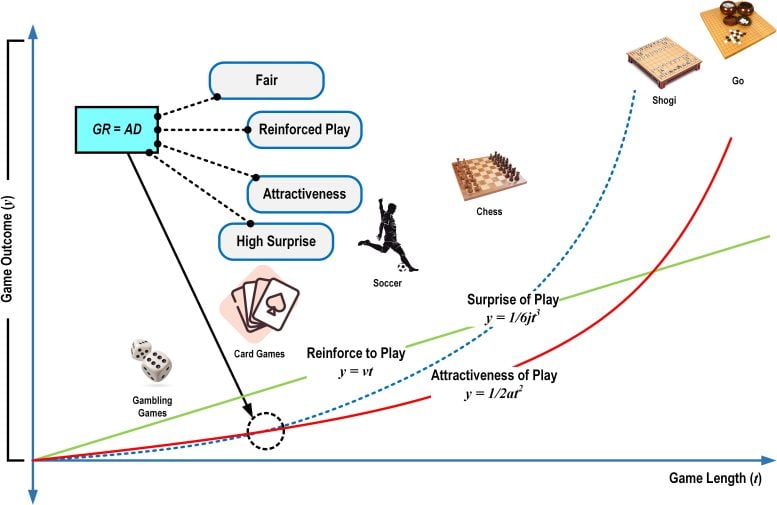
Card games are a popular form of entertainment that have been enjoyed for centuries. They come in a variety of styles, from classic games like Poker and Blackjack to modern games like Hearthstone and Magic the Gathering.
The researchers employed game refinement, the motion-in-mind model, and AI simulations to assess the impact of sudden movements in card games with incomplete information.
A jerk is a measurement of a sudden acceleration change and is commonly used in fields such as engineering, sports science, manufacturing, and more. Researchers have now proposed that examining the impact of jerks can also offer deeper insights into gameplay. The game refinement theory posits that acceleration, or the rate at which information speed changes, represents the balance between certainty and uncertainty in a game. This balance is referred to as the game refinement value (GR) and serves as an indicator of a player’s level of engagement.
A new perspective, the motion-in-mind model, measures the uncertainty of progress in a game relative to two physical measures—velocity, which represents the win rate, and mass, which represents how hard it is to win. These physical values can be translated into psychological reactions. A jerk—denoted as AD, an abbreviation for addictive—can thus be interpreted as unpredictability or surprise. Games with a higher AD value are highly unpredictable and full of surprises, making them addictive.
Recently, a group of researchers led by Assistant Professor Mohd. Nor Akmal Khalid from the School of Information Science, Japan Advanced Institute of Science and Technology (JAIST), has investigated the influence of jerks on game addiction through several popular card games—these included suits-irrelevant (Wakeng and Doudizhu) and suits-relevant (Winner, Big Two, and Tien Len) games. The study, which was co-authored by Professor Hiroyuki Iida of JAIST, was recently published in the journal IEEE Access.

Researchers from JAIST highlight the importance of cross points between GR (y = 1/2at2) and AD (y = 1/6jt3) curves, where the elementary components of play were identified and established the principle of play, based on data of card games and previously conducted studies on similar topics. Credit: Mohd. Nor Akmal Khalid from JAIST
Prof. Khalid discusses the motivation behind the research. “Card games are typical incomplete information games. Short, repeatable rounds, chances, and strategizing make them among the most entertaining, even addictive, games. We wanted to understand why this was so.”
The researchers first explored the rules, designs, and complexities of these games, using game refinement and the motion-in-mind model. Next, they performed two simulations with self-playing artificial intelligence (AI) agents. In the first experiment, the AI mimicked a fixed game played by contestants with different skill levels (weak, fair, and strong). In contrast, the second experiment comprised games of various sophistications played by a fixed AI level. The differences between two parameters were observed—first, the odds of winning (as seen in games with deterministic versus random odds), and second, the difficulty level (as seen in simple versus complex games). These analyses enabled researchers to compare the different card games.
The results demonstrate that skill and sophistication must match for reasonable GR (correlated with attractiveness) and AD (correlated with surprise) values. In addition, the games must also be balanced and fair enough, so that winning is not interpreted as just good luck. Take Doudizhu for example, which has nearly equal GR and AD values. This balance between uncertainty and unpredictability leads to a fast-paced game with frequent rewards and surprises. As a result, people want to play repeatedly, making Doudizhu the most popular and addictive card game.
Through the above investigation, the researchers discerned the principles of play for addictive entertainment. The four measures of the game progress model—game length, velocity, acceleration, and jerk—correspond respectively to reward cost, reward frequency, uncertainty, and unpredictability. Further, they determine game fairness, reinforcement, attractiveness, and surprise, respectively.
“These components highlight the potential of GR and AD measures as powerful tools to understand gameplay. They will prove useful in making games more attractive and educational. Not just games, the findings of this study can be extended to help make any normal and mundane activity engaging, enjoyable, surprising, and even addictive. In essence, the boundary between work and play can get blurred, leading to an ultimate sense of achievement and passion,” concludes Prof. Khalid.
Reference: “Implications of Jerk’s On the Measure of Game’s Entertainment: Discovering Potentially Addictive Games” by Naying Gao, Hengyuan Chang, Zeliang Zhang, Mohd Nor Akmal Khalid and Hiroyuki Iida, 26 December 2022, IEEE Access.
DOI: 10.1109/ACCESS.2022.3232520
The study was funded by the Japan Society for the Promotion of Science.








… because the card games are just the card games…
Hello. Thank you fot the article.